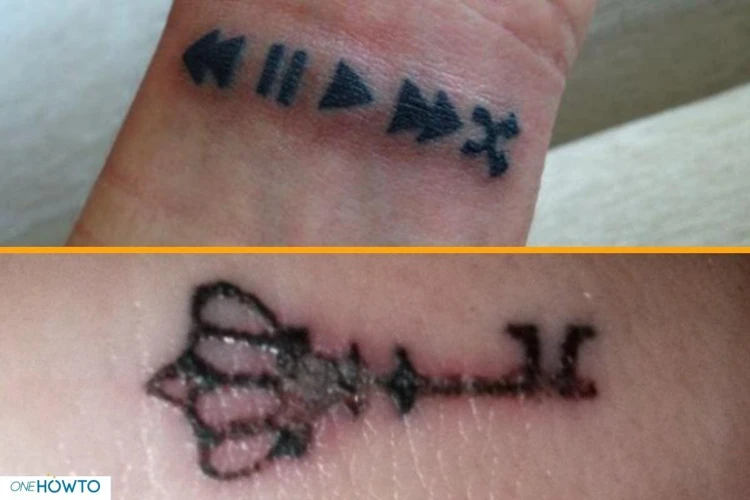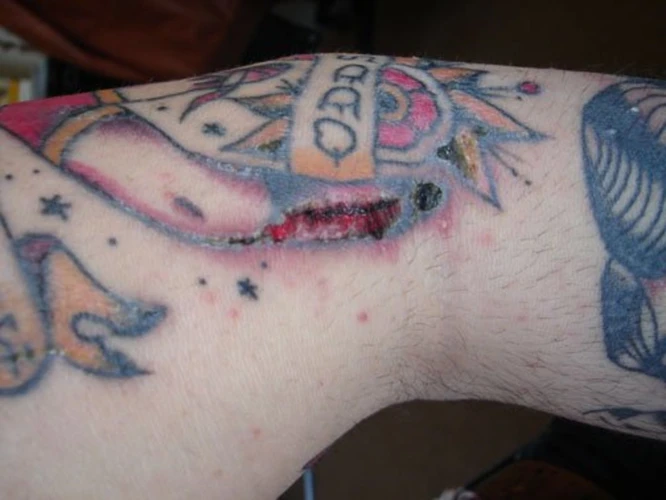If you’ve recently gotten a tattoo, you’ve probably noticed some swelling and discomfort in the area around the tattoo. While this is normal, it can be uncomfortable and slow down the healing process. So, if you’re looking for ways to reduce tattoo swelling, here are five proven techniques to help speed up the healing process.
Contents
Why are Tattoos Raised?

Immediately After Receiving a Tattoo
When initially getting a tattoo, it is normal for it to appear raised as the body’s natural response to the trauma of the needles. The swelling and inflammation that occur are the body’s natural way of healing and protecting the area. This is why it is important to care for the area properly and allow it to heal.
Why are My Tattoos Raised Years Later?
It is possible for tattoos to become raised even years after they were done, as the body continues to heal and adjust to the presence of the ink. This is usually due to the body’s immune system responding to the foreign material in the skin, as well as the buildup of scar tissue. The swelling can be a sign of an allergic reaction or infection, so it is important to monitor the area and contact a doctor if it persists.
Why is My Old Tattoo Raised?
In some cases, an old tattoo may become raised due to a buildup of scar tissue or the body’s response to the ink. This can be caused by a number of factors, including improper aftercare, an allergic reaction, or a deeper-lying medical condition. If the raised area is accompanied by pain or any other symptoms, it is important to seek medical advice.
What Causes Tattoo Swelling?

Tattoo swelling is a common occurrence after getting a tattoo. It is usually caused by the trauma that occurs when the ink is injected into the skin. The body’s natural response to this trauma is to create inflammation, which is what causes the swelling. Other common causes of swelling include infection, allergic reaction, and even over-moisturizing.
Why Am I Getting Bumps on My Tattoo?
Bumps on a tattoo can occur for several reasons. It could be due to an allergic reaction to the ink, or it could be due to an infection. It could also be due to excessive moisture or over-moisturizing. If you notice any bumps, it is important to seek medical attention as soon as possible.
Why is My Tattoo Puffy?
Tattoo puffiness is usually due to the trauma of the tattooing process. The body reacts to the trauma by creating inflammation, which can cause the tattoo to become puffy. It is also possible that the tattoo artist may have gone too deep when injecting the ink, which can cause the skin to swell. Another reason for puffiness could be due to an allergic reaction to the ink, or an infection. Why does my tattoo feel raised years later? This could be due to scar tissue that has formed around the area. Over time, the scar tissue can create a raised texture on the skin.
Techniques to Reduce Tattoo Swelling

Keeping the Tattoo Clean
It is essential to keep your new tattoo clean to reduce swelling. Wash your hands before and after touching the tattoo and use a mild, fragrance-free soap and warm water to gently wash the area. Pat dry with a clean towel.
Applying Ice to Reduce Swelling
Applying a cold compress to the tattoo can help reduce swelling. Wrap an ice cube in a clean cloth and apply it to the area for up to 15 minutes. Do not apply ice directly to the skin, as this can cause frostbite.
Wear Loose and Breathable Clothing
Wearing loose and breathable clothing can help reduce swelling. Avoid tight and restrictive clothing that can put pressure on the area.
Avoid Touching and Scratching
Touching or scratching the tattoo can cause irritation and lead to increased swelling. Avoid touching or scratching the area to reduce swelling.
Apply Aftercare Products
Applying aftercare products such as lotions and ointments can help reduce swelling. Make sure to choose products specifically designed for tattoos and follow the instructions on the packaging.
Following these techniques can help reduce swelling and speed up the healing process of a new tattoo. It is also important to be aware of the signs of infection, such as redness, swelling, and pain, which can occur if the tattoo is not cared for properly. If you have an old tattoo that is raised, it could be due to an infection and it is important to seek medical attention.
How Long Do Hand Tattoos Stay Swollen?
Hand tattoos can stay swollen for up to a few days after getting them done. This is normal as the skin is trying to heal itself and may cause some tenderness or discomfort. The swelling should start to subside within a few days and can be helped with the following techniques:
- Apply cold compresses – applying cold compresses can help reduce the swelling and inflammation. Use a clean cloth soaked in cold water and place it directly on the tattoo for 15-20 minutes at a time.
- Keep the area clean – it is important to keep the area clean in order to prevent infection. Use a mild antibacterial soap and warm water to clean the area twice a day.
- Use an ointment – using a mild, fragrance-free ointment can help keep the skin moisturized and prevent it from drying out. Apply a thin layer of ointment twice a day for the first week.
- Avoid sun exposure – sun exposure can cause damage to the tattoo and should be avoided for at least 2 weeks. When outdoors, wear loose clothing over the tattoo to protect it from the sun’s harmful rays.
- See a doctor – if the swelling does not go down after a few days or if you notice bumps on the tattoo, it is important to see a doctor. These bumps may be an indication of an infection or allergic reaction to the ink, and should be treated immediately.
By following these simple steps, you can reduce the swelling and help speed up the healing process. If you are still experiencing swelling after a few days, or you are noticing bumps on the tattoo, it is important to seek medical advice.
Frequently Asked Questions
What are the Most Common Causes of Swelling After Getting a Tattoo?
Swelling after getting a tattoo is caused by various factors, such as the needle used, the depth of the injection, the design, the size of the tattoo, and the location of the tattoo on the body. In some cases, swelling can also be caused by an allergic reaction or infection. Additionally, swelling can be caused by the body’s natural response to the trauma of a needle piercing the skin.
Are there any home remedies that can help reduce swelling after getting a tattoo?
Yes, there are. Home remedies such as cold compresses, elevation of the tattooed area, and natural ointments can help reduce swelling and help speed up the healing process. Here are some proven techniques to help reduce swelling after getting a tattoo:
- Cold Compresses: Cold compresses can help reduce swelling and inflammation. Applying a cold compress to the tattooed area for 15 minutes at a time several times a day can help reduce swelling and help speed up the healing process.
- Elevation: Keeping the tattooed area elevated above the heart can help reduce swelling. This can be done by propping up the area with pillows or other items.
- Natural Ointments: Natural ointments such as aloe vera or coconut oil can help reduce swelling and speed up the healing process. These ointments should be applied to the tattooed area several times a day.
- Gentle Massage: Gentle massage of the tattooed area can help reduce swelling and speed up the healing process. Massage should be done in a circular motion for several minutes at a time.
- Hydration: Staying hydrated can help reduce swelling and speed up the healing process. Drinking plenty of water throughout the day can help the body heal faster.
By following these techniques, you can help reduce swelling after getting a tattoo and help speed up the healing process.
What are the best ways to reduce redness and irritation from a new tattoo?
- Keep it clean: Gently wash the tattoo with lukewarm water and antibacterial soap. Pat dry with a clean towel.
- Apply a cold compress: Use a cold compress to reduce swelling and redness. Do this for 5-10 minutes at a time.
- Moisturize: Use a tattoo-friendly lotion or ointment to moisturize the area. This will help keep the skin from drying out and prevent scabbing.
- Avoid sun exposure: Keep the tattoo out of direct sunlight and wear sunscreen when outside. This will reduce the risk of fading and discoloration.
- See a doctor: If the redness and irritation persist, see a doctor to rule out any underlying medical conditions.
Is it safe to use Ice to Reduce Swelling After Getting a Tattoo?
Yes, it is safe to use ice to reduce swelling after getting a tattoo. Ice helps reduce inflammation and pain, and can be applied for 15 minutes at a time every hour. Make sure to use a cold compress (or a bag of frozen vegetables wrapped in a cloth) to avoid direct contact with the skin to prevent further irritation.
How Long Can it Take for a Tattoo to Fully Heal and the Swelling to Go Down?
The healing time of a tattoo depends on various factors like size, location, and the expertise of the artist. Generally, a tattoo can take anywhere from 3-4 weeks to fully heal. The swelling, however, may last up to 3-5 days, depending on the area of the body and the amount of ink used. To reduce swelling, rest, apply ice, clean the area regularly, and wear loose clothing are important.
Conclusion
Given the potential risks associated with tattoo swelling, it is important to take the necessary steps to reduce swelling and speed up the healing process. Using the techniques outlined above, such as taking anti-inflammatories, applying ice packs and avoiding sun exposure, can help to reduce swelling and prevent any lasting damage to the tattoo.